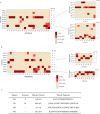Linear epitopes on the capsid protein of norovirus commonly elicit high antibody response among past-infected individuals
- PMID: 37280660
- PMCID: PMC10242594
- DOI: 10.1186/s12985-023-02087-y
Linear epitopes on the capsid protein of norovirus commonly elicit high antibody response among past-infected individuals
Abstract
Background: Human norovirus (HuNoV) is the leading cause of acute nonbacterial gastroenteritis globally, and its infection is usually self-limited, so most people become past Norovirus (NoV)-infected individuals. It is known that some antibody responses may play a critical role in preventing viral infection and alleviating disease; however, the characteristics and functions of particular antibody responses in persons with previous infections are not fully understood. Capsid proteins, including VP1 and VP2, are crucial antigenic components of NoV and may regulate antibody immune responses, while epitope-specific antibody responses to capsid proteins have not been comprehensively characterized.
Methods: We prepared purified VP1 and VP2 proteins by ion exchange chromatography and measured serum antigen-specific IgG levels in 398 individuals by ELISA. Overlapping 18-mer peptides covering the full length of VP1 and VP2 were synthesized, and then we identified linear antigenic epitopes from 20 subjects with strong IgG positivity. Subsequently, specific antibody responses to these epitopes were validated in 185 past infected individuals, and the conservation of epitopes was analyzed. Finally, we obtained epitope-specific antiserum by immunizing mice and expressed virus-like particles (VLPs) in an insect expression system for a blockade antibody assay to evaluate the receptor-blocking ability of epitope-specific antibodies.
Results: The IgG responses of VP1 were significantly stronger than those of VP2, both of which had high positive rates of over 80%. The overall positive rate of VP1-IgG and/or VP2-IgG was approximately 94%, which may be past NoV-infected individuals. Four linear antigenic B-cell epitopes of capsid proteins were identified, namely, VP1199-216, VP1469-492, VP297-120, and VP2241-264, all of which were conserved. The IgG response rates of the above epitopes in past NoV-infected individuals were 38.92%, 22.16%, 8.11% and 28.11%, respectively. In addition, VP1199-216- and VP1469-492-specific antibodies can partially block the binding of VLPs to the receptor histo-blood group antigen (HBGA).
Conclusion: This is the first study to describe specific antibody responses of VP2 and to identify its B-cell epitopes. Our findings offer data for a more thorough understanding of norovirus capsid protein-specific IgG responses and could provide useful information for designing and developing vaccines.
Keywords: Epitopes; IgG; Norovirus; VP1; VP2.
© 2023. The Author(s).
Conflict of interest statement
The authors declare no competing interests.
Figures





Similar articles
-
Type-specific and cross-reactive antibodies and T cell responses in norovirus VLP immunized mice are targeted both to conserved and variable domains of capsid VP1 protein.Mol Immunol. 2016 Oct;78:27-37. doi: 10.1016/j.molimm.2016.08.009. Epub 2016 Aug 29. Mol Immunol. 2016. PMID: 27573255
-
Epitope type-specific IgG responses to capsid proteins VP1 and VP2 of human parvovirus B19.J Infect Dis. 1995 Dec;172(6):1431-6. doi: 10.1093/infdis/172.6.1431. J Infect Dis. 1995. PMID: 7594699
-
High-Resolution Mapping of Human Norovirus Antigens via Genomic Phage Display Library Selections and Deep Sequencing.J Virol. 2020 Dec 9;95(1):e01495-20. doi: 10.1128/JVI.01495-20. Print 2020 Dec 9. J Virol. 2020. PMID: 33055250 Free PMC article.
-
The Antigenic Topology of Norovirus as Defined by B and T Cell Epitope Mapping: Implications for Universal Vaccines and Therapeutics.Viruses. 2019 May 10;11(5):432. doi: 10.3390/v11050432. Viruses. 2019. PMID: 31083353 Free PMC article. Review.
-
GII.4 Human Norovirus: Surveying the Antigenic Landscape.Viruses. 2019 Feb 20;11(2):177. doi: 10.3390/v11020177. Viruses. 2019. PMID: 30791623 Free PMC article. Review.
Cited by
-
Mechanism research of Punicalagin in treating representative strains of enterovirus A and B types based on systems pharmacology and experimental validation.Virol J. 2025 Jul 9;22(1):229. doi: 10.1186/s12985-025-02845-0. Virol J. 2025. PMID: 40634970 Free PMC article.
References
-
- van Asten L, Siebenga J, van den Wijngaard C, Verheij R, van Vliet H, Kretzschmar M, et al. Unspecified gastroenteritis illness and deaths in the elderly associated with norovirus epidemics. Epidemiology. 2011;22(3):336–343. - PubMed
-
- Fernandez JM, Gomez JB. Norovirus infections. Enferm Infecc Microbiol Clin. 2010;28(Suppl 1):51–55. - PubMed
Publication types
MeSH terms
Substances
LinkOut - more resources
Full Text Sources
Medical
Miscellaneous

